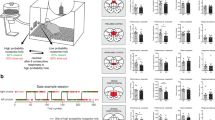Abstract
Rationale. Lesions of the orbital prefrontal cortex (OPFC) can cause pathologically impulsive behaviour in humans. Inter-temporal choice behaviour (choice between reinforcers differing in size and delay) has been proposed as a model of "impulsive choice" in animals.
Objective. A quantitative method was used to analyse inter-temporal choice in rats with lesions of the OPFC and sham-lesioned control rats.
Methods. Under halothane anaesthesia, rats received injections of the excitotoxin quinolinate into the OPFC (0.1 M, 0.5 µl; two injections in each hemisphere), or sham lesions (injections of the vehicle). They were trained to press two levers (A and B) for sucrose reinforcement (0.6 M) in discrete-trials schedules. In free-choice trials, a press on A resulted in delivery of 50 µl of the sucrose solution after a delay d A ; a press on B resulted in delivery of 100 µl of the same solution after a delay d B . d B was increased progressively across successive blocks of six trials in each session, while d A was manipulated systematically across phases of the experiment. The indifference delay, d B(50) (value of d B corresponding to 50% choice of B) was estimated for each rat in each phase. Linear functions of d B(50) versus d A were derived, and the parameters of the function compared between the groups. The locations of the lesions were verified histologically at the end of the experiment.
Results. In both groups, d B(50) increased linearly with d A (r 2>0.98 in each case). The slope of the function was significantly steeper in the lesioned group than the sham-lesioned group, whereas the intercept did not differ significantly between the groups. The brains of the lesioned rats showed extensive atrophy/gliosis of the OPFC, with sparing of the dorsolateral prefrontal cortex.
Conclusions. The results indicate that lesions of the OPFC can alter inter-temporal choice, either promoting or suppressing "impulsive choice", depending upon the relative sizes and delays of the two choice alternatives. Theoretical analysis based on a quantitative model of inter-temporal choice indicates that the pattern of effect of the OPFC lesion is likely to reflect two actions: (i) an increase in the rate of time discounting; (ii) an increase in sensitivity to the ratio of the sizes of two reinforcers.
Similar content being viewed by others
Author information
Authors and Affiliations
Additional information
Electronic Publication
Rights and permissions
About this article
Cite this article
Kheramin, .S., Body, .S., Mobini, .S. et al. Effects of quinolinic acid-induced lesions of the orbital prefrontal cortex on inter-temporal choice: a quantitative analysis. Psychopharmacology 165, 9–17 (2002). https://doi.org/10.1007/s00213-002-1228-6
Received:
Accepted:
Issue Date:
DOI: https://doi.org/10.1007/s00213-002-1228-6




